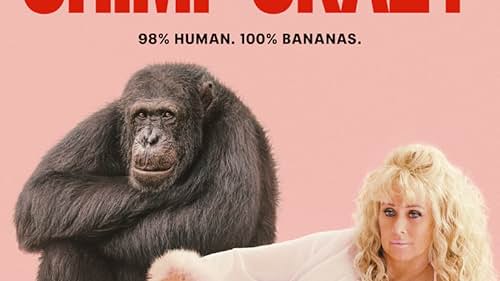Chimp Crazy Review 2024 Tv Show Series Cast Crew Online
In the 1997 movie “Buddy,” Rene Russo plays a wealthy, eccentric collector of wild animals. Hoarder might be a more fitting description. Chimpanzees are among the animals in her possession. Alan Cumming co-stars and he’s interviewed in the deeply unsettling four-part HBO docuseries “Chimp Crazy” talking about his experiences on the film, which he says is “really about the fact that you can’t tame wild things, you have to let them be themselves. You have to let them go.” Of course, the irony is that in order to capture that on screen, the animals used in the film weren’t allowed to be themselves at all, but some unnatural version of what Hollywood — and their trainers — wanted.
Director Eric Goode previously made “Tiger King” for Netflix, and with this project he offers another excoriating look at the exotic animal industry, specifically private chimpanzee ownership in the U.S. The series’ primary focus is a woman named Tonia Haddix. At the outset, she is working at a deceptively official-sounding facility called the Missouri Primate Foundation, where a chimp named Tonka — who appeared alongside Cumming in “Buddy” — is now middle-aged and kept alone in a cage.
“My understanding of what happened to Tonka after his Hollywood career ended was that he retired to Palm Springs,” says Cumming, perhaps naively. “That’s what I was told.”
Instead, Tonka is housed in that Missouri location, which is owned by a longtime chimp breeder named Connie Cassie. According to the documentary, she is responsible for three-quarters of the captive-bred chimps in the U.S. She does not want to talk on camera, but Haddix is eager to do so in her place.
Haddix has an ostentatious appearance and calls herself the “Dolly Parton of chimps,” with her big blonde hair, acrylic nails and buxom figure. She’s an accommodating and talkative documentary subject, but also something of a performance artist who will go to great lengths to maintain the fiction that there’s nothing wrong with keeping chimps as pets.
When Cumming learns of Tonka’s fate, he has concerns. Goode asks if he worries people will accuse him of being a hypocrite. “Well, I don’t worry about it,” Cumming replies. “It’s true. But that’s 30 years ago and I have changed and the world has changed. I think they’re right.”
Goode occasionally appears on camera, because the making of this documentary is also part of the story. Goode says that because of his work on “Tiger King,” he is treated with suspicion by those in the exotic animal industry. So he hires a “proxy director” named Dwayne Cunningham (who had a circus background before becoming “involved in the animal industry,” as he puts it) to go undercover and film the portions with Haddix.
This decision crosses all kinds of ethical lines. Documentary filmmaking doesn’t necessarily follow the kind of editorial standards that might apply to investigative journalism. Who is Goode answerable to, exactly? Unclear. Is it fair for a filmmaker to lie to a person in order to gain their trust and consent? It’s a worthy debate, and the series isn’t necessarily glib about it either. Whether you agree with Goode’s tactics or not, I wish he had been more transparent about his thought process. Audiences deserve a richer context that would have deepened everyone’s media literacy, because the other more clear and obvious moral quandaries — about how these chimps are treated — have a way of overpowering any other uneasiness viewers may have about the project.
Captivity in someone’s private home is detrimental to these animals. But humans often pay a price as well when chimps grow to their full size and violently rebel from their “humanzee” existence. Goode goes into detail about two notorious attacks and the details are devastating to all involved. “He ripped her face off!” a chimp owner in Connecticut can be heard on a 911 call, amidst sounds of the chimp’s distressed screeching. A visiting friend, who had known the chimp since it was a baby, was attacked and lost her eyes, her nose, her jaw and part of her skull. Amazingly, she survived. Here’s how the stepdaughter of the chimp’s owner describes what happened next: “After having her friend be completely torn up and almost killed by a chimp, (she) went out one year later and bought herself another chimp. It’s insane when you think about it.”
In Missouri, when Haddix shows Cunningham and the film crew around the premises, the chimps are loud and agitated, banging on the bars and walls. She feeds them McDonalds and sports drinks as treats. The Missouri Primate Foundation was originally a for-profit company called Chimparty, which hired out young and pliable chimps as birthday party entertainment. Some of the chimps were also used as animal actors, or models for greeting cards.
A volunteer named Angela Scott says, “The older chimps that weren’t doing parties, they didn’t get a lot of attention. They sit in a cage and do nothing all day long.” Journalist Peter Laufer describes the location as a “ghastly prison for chimpanzees” and says Cassie is “operating the equivalent of a puppy mill.” When she changed Chimparty to the non-profit Missouri Primate Foundation, Laufer calls it a form of greenwashing.
Eventually, Scott contacted People for the Ethical Treatment of Animals and provided proof that the chips were being held in barren enclosures “strewn with trash and their own waste.” PETA sued in 2017, asking the court to transfer the chimps to an accredited sanctuary. The judge agreed. But on the day of the move, Tonka was missing. Where was Tonka? Haddix claimed he had recently died.
HBO is categorizing certain aspects of the documentary as spoilers, which I will respect, however the story has been widely reported already and facts are not “spoilers.” Framing them as such is yet another questionable ethical choice here, but Goode’s methods are legitimately gripping, even if they stray into all kinds of gray areas. I found that the docuseries stayed with me for days after I watched, and it has affected how I think about all our interactions with animals, both domesticated and wild. These relationships can turn sour when humans force animals into situations that suit us but not them, and expect unconditional love, or something like it, when the reality is far more complicated.
Haddix and many others talk about the chimps as if they are their children, rather than a different species with psychological needs all their own. It’s a mindset that seems rooted in the desire to be needed, but also a desire to control another living creature in ways you simply can not with human beings, who will talk back and tell you to buzz off. Of course, once big enough, chimps will do the same. Not with words, but with their actions.
“I think she feels that nobody needs her, ” says Haddix’s son. “I love her to death and tell her all the time. I think if you asked her, she would say that I don’t need her and she’s not important in my life, which is very untrue.” But that’s where the attraction to these primates comes in, he says. “They’re like children that never grow up. So they’re constantly going to need her care, 24 hours a day, seven days a week, 365 days a year.”




